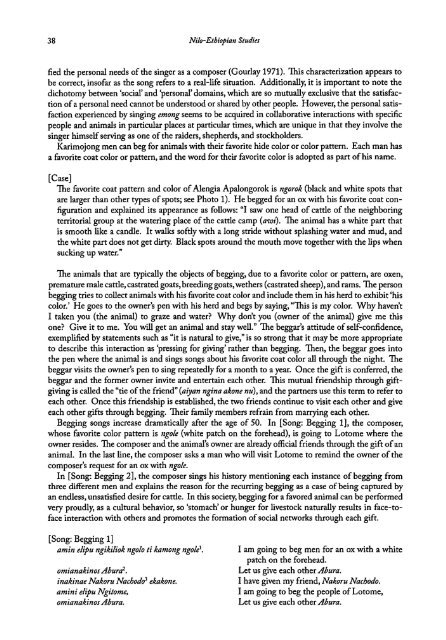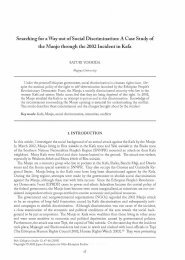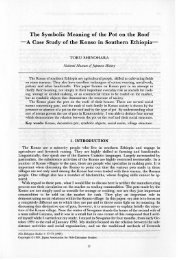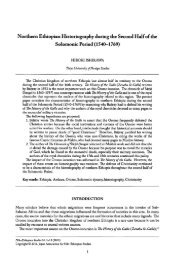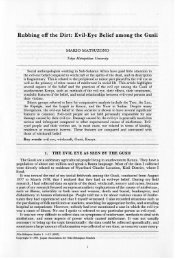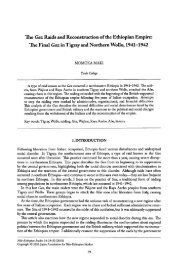Daily Life as Poetry: The Meaning of the Pastoral Songs of the ...
Daily Life as Poetry: The Meaning of the Pastoral Songs of the ...
Daily Life as Poetry: The Meaning of the Pastoral Songs of the ...
You also want an ePaper? Increase the reach of your titles
YUMPU automatically turns print PDFs into web optimized ePapers that Google loves.
38 Nilo-Ethiopian Studies<br />
fied <strong>the</strong> personal needs <strong>of</strong> <strong>the</strong> singer <strong>as</strong> a composer {Gourlay 1971). This characterization appears to<br />
be correct, ins<strong>of</strong>ar <strong>as</strong> <strong>the</strong> song refers to a real-life situation. Additionally, it is important to note <strong>the</strong><br />
dichotomy between 'social' and 'personal' domains, which are so mutually exclusive that <strong>the</strong> satisfaction<br />
<strong>of</strong> a personal need cannot be understood or shared by o<strong>the</strong>r people. However, <strong>the</strong> personal satisfaction<br />
experienced by singing emong seems to be acquired in collaborative interactions with specific<br />
people and animals in particular places at particular times, which are unique in that <strong>the</strong>y involve <strong>the</strong><br />
singer himself serving <strong>as</strong> one <strong>of</strong> <strong>the</strong> raiders, shepherds, and stockholders.<br />
Karimojong men can beg for animals with <strong>the</strong>ir favorite hide color or color pattern. Each man h<strong>as</strong><br />
a favorite coat color or pattern, and <strong>the</strong> word for <strong>the</strong>ir favorite color is adopted <strong>as</strong> part <strong>of</strong> his name.<br />
[C<strong>as</strong>e]<br />
<strong>The</strong> favorite coat pattern and color <strong>of</strong> Alengia Apalongorok is ngorok {black and white spots that<br />
are larger than o<strong>the</strong>r types <strong>of</strong> spots; see Photo 1). He begged for an ox with his favorite coat configuration<br />
and explained its appearance <strong>as</strong> follows: "I saw one head <strong>of</strong> cattle <strong>of</strong> <strong>the</strong> neighboring<br />
territorial group at <strong>the</strong> watering place <strong>of</strong> <strong>the</strong> cattle camp (awi). <strong>The</strong> animal h<strong>as</strong> a white part that<br />
is smooth like a candle. It walks s<strong>of</strong>tly with a long stride without spl<strong>as</strong>hing water and mud, and<br />
<strong>the</strong> white part does not get dirty. Black spots around <strong>the</strong> mouth move toge<strong>the</strong>r with <strong>the</strong> lips when<br />
sucking up water."<br />
<strong>The</strong> animals that are typically <strong>the</strong> objects <strong>of</strong> begging, due to a favorite color or pattern, are oxen,<br />
premature male cattle, c<strong>as</strong>trated goats, breeding goats, we<strong>the</strong>rs {c<strong>as</strong>trated sheep), and rams. <strong>The</strong> person<br />
begging tries to collect animals with his favorite coat color and include <strong>the</strong>m in his herd to exhibit 'his<br />
color.' He goes to <strong>the</strong> owner's pen with his herd and begs by saying, "This is my color. Why haven't<br />
I taken you {<strong>the</strong> animal) to graze and water? Why don't you {owner <strong>of</strong> <strong>the</strong> animal) give me this<br />
one? Give it to me. You will get an animal and stay well." <strong>The</strong> beggar's attitude <strong>of</strong> self-confidence,<br />
exemplified by statements such <strong>as</strong> "it is natural to give," is so strong that it may be more appropriate<br />
to describe this interaction <strong>as</strong> 'pressing for giving' ra<strong>the</strong>r than begging. <strong>The</strong>n, <strong>the</strong> beggar goes into<br />
<strong>the</strong> pen where <strong>the</strong> animal is and sings songs about his favorite coat color all through <strong>the</strong> night. <strong>The</strong><br />
beggar visits <strong>the</strong> owner's pen to sing repeatedly for a month to a year. Once <strong>the</strong> gift is conferred, <strong>the</strong><br />
beggar and <strong>the</strong> former owner invite and entertain each o<strong>the</strong>r. This mutual friendship through giftgiving<br />
is called <strong>the</strong> "tie <strong>of</strong> <strong>the</strong> friend" (aiyan ngina akone nu), and <strong>the</strong> partners use this term to refer to<br />
each o<strong>the</strong>r. Once this friendship is established, <strong>the</strong> two friends continue to visit each o<strong>the</strong>r and give<br />
each o<strong>the</strong>r gifts through begging. <strong>The</strong>ir family members refrain from marrying each o<strong>the</strong>r.<br />
Begging songs incre<strong>as</strong>e dramatically after <strong>the</strong> age <strong>of</strong> 50. In [Song: Begging 1], <strong>the</strong> composer,<br />
whose favorite color pattern is ngole {white patch on <strong>the</strong> forehead), is going to Lotome where <strong>the</strong><br />
owner resides. <strong>The</strong> composer and <strong>the</strong> animal's owner are already <strong>of</strong>ficial friends through <strong>the</strong> gift <strong>of</strong> an<br />
animal. In <strong>the</strong> l<strong>as</strong>t line, <strong>the</strong> composer <strong>as</strong>ks a man who will visit Lotome to remind <strong>the</strong> owner <strong>of</strong> <strong>the</strong><br />
composer's request for an ox with ngole.<br />
In [Song: Begging 2], <strong>the</strong> composer sings his history mentioning each instance <strong>of</strong> begging from<br />
three different men and explains <strong>the</strong> re<strong>as</strong>on for <strong>the</strong> recurring begging <strong>as</strong> a c<strong>as</strong>e <strong>of</strong> being captured by<br />
an endless, unsatisfied desire for cattle. In this society, begging for a favored animal can be performed<br />
very proudly, <strong>as</strong> a cultural behavior, so 'stomach' or hunger for livestock naturally results in face-t<strong>of</strong>ace<br />
interaction with o<strong>the</strong>rs and promotes <strong>the</strong> formation <strong>of</strong> social networks through each gift.<br />
[Song: Begging 1]<br />
am in elipu ngikiliok ngolo ti kamong ngole 1 •<br />
omianakinos Aburti.<br />
inakinae Nakoru NachodrJ ekakone.<br />
amini elipu Ngitome,<br />
omianakinos Abura.<br />
I am going to beg men for an ox with a white<br />
patch on <strong>the</strong> forehead.<br />
Let us give each o<strong>the</strong>r Abura.<br />
I have given my friend, Nakoru Nachodo.<br />
I am going to beg <strong>the</strong> people <strong>of</strong> Lotome,<br />
Let us give each o<strong>the</strong>r Abura.


